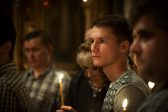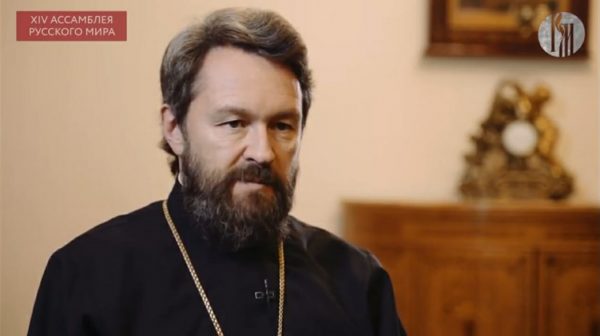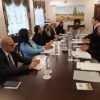Metropolitan Hilarion spoke in an interview with Kommersant daily about prospects for reunification of the Russian Orthodox Church and Old-Believers.
– Fifty years ago a Local Council of the Russian Orthodox Church decided to lift up old ‘anathemas’ imposed by the 1667 Great Council of Moscow. What has changed for Old Believers after the 1971 Council?
– The decisions of the 1971 Local Council of the Russian Orthodox Church are historic. They symbolize the serious intention of the Russian Church to hold dialogue with the Old Rite, the ultimate aim of this is, of course, the overcoming of the centuries-old divisions. It is a difficult and long path we all have to traverse.
But the decisions of the Council helped take off the mutual alienation. An opportunity arose for establishing dialogue, participating in joint projects, exhibitions, festivals. Now cooperation is developing in many areas of socio-cultural life. For instance, representatives of the Russian Orthodox Old-Rite Church led by Metropolitan Korniliy annually take part in the World Russian People’s Council and other forums organized by the Russian Orthodox Church. Some representatives of the Old-Rite Hierarchies are graduates fr om theological schools of the Russian Orthodox Church or continue to study in them. Old Rite people are developing pilgrimages to Russian-wide shrines in Orthodox churches or monasteries.
There are numerous examples of business cooperation between Orthodox Christians and Old-Rite people on the local level.
– Some time ago, you stated that you in the Russian Orthodox Church do not see any obstacles for reunion of the Russian Orthodox Church and the Russian Orthodox Old-Rite Church in one Church. On what terms can it be done?
– We see an internal obstacle on the ROORC side: the reunion is impossible if one of the sides considers the other ‘heretical’. A shared necessary condition for reunion is mutual recognition of each other as Orthodox in the field of doctrine. The 1988 Local Council of the Russian Orthodox Church adopted ‘An Appeal to All Orthodox Christians Who Uphold Old Rites and Have No Communion in Prayer with the Moscow Patriarchate’. In this document, a call was voiced to dialogue that could promote the development of mutual understanding.
As for the organizational side of unification, the events of this century clearly show: all problems can be solved if there a good will of the both sides to restore unity, as was the case, for instance, with the reunification with the Russian Church Outside Russia.
– Are there any attempts undertaken by the Russian Orthodox Church to begin negotiations on unification with Old-Rite believers?
– If to speak precisely about unification, then there were no such attempts. The nature of relationships at present is boiled down not to negotiations on unification but rather actions for overcoming the historically developed alienation, mutual distrust. There is still a great deal of prejudice on both sides, a distorted notion of each other. To speak about unification seriously it is necessary first to clarify theologically and canonically what exactly still divides us.
– What does impede the unification of the two Churches – is it only differences in church rites?
– Unfortunately, not only differences as to the rites. From the practical angle, the Old Rite, for instance, has a stricter and more straightforward approach to the invocation of church canons and even life conventions, such as wearing beards, etc. Besides, there are Old-Rite hierarchies whose apocalyptic moods are so acute that they lead to decisions that cannot be recognized by the Orthodox, such as rejection of priesthood, some Sacraments, etc.
– Is it possible in your view to overcome centuries-old differences, and if yes then how?
– Certainly, the longer the time of disunion lasts the more difficult it is to overcome it. And in case of the Old Rite, there were not only differences but also persecutions by the authorities up to the most terrible ones which took the toll of thousands of lives or made people flee the country. It is not easy to overcome historical memory.
Meanwhile, the Russian Orthodox Church does have an experience of such overcoming. Since 1800, there have been in her fold the so-called Same-Faith parishes (now commonly called Old-Rite Believers), in which Old-Rite Believers who have reunited with the Church can worship according to the old Russian rite while keeping canonical communion with her Supreme Authority. The number of such parishes is gradually growing, and there is even a Patriarchal Center of Old Russian Tradition established at the Moscow church of the Intercession of the Most Holy Mother of God at Rubtsovo, wh ere they publish literature for Old-Rite parishes and train readers and choristers and make researches into medieval music and historical liturgics.
– What are the Moscow Patriarchate’s relationships with Old-Rite Believers now?
– The Holy Authority of the Russian Orthodox Church is deeply aware of the pernicious consequences of the17th century church schism and believes it to be a national tragedy, and for this reason it never deviates from an opportunity for healing this consequences somehow.
Relations may be not only official, inter-church but also inter-personal. And in them, precisely after the 1971 Council, things are rather favourable as the mutual alienation is gradually dying down. And, it should be mentioned, that the reunion of many Old-Rite Believers with the Russian Orthodox Church, sometimes involving whole families, represent a notable phenomenon in the church life of today’s Russia.
– Does the Orthodox Church recognize the ROORC hierarchy?
– The ROORC hierarchy (the so-called Belokrinitskaya Hierarchy) was unilaterally founded in 1846 by then retired former Metropolitan Ambrose of Bosnia-Sarajevo (Papageorgopolos) at the village of Bila Krynytsia, which was located at that time in the territory of Austria-Hungary (now it belongs to Ukraine’s Chernovtsy region). The legitimacy of the Belokrinitskaya Hierarchy was not recognized by the Russian Empire.
In 2014, the Old-Rite Metropolitan Korniliy of Moscow and All Russia proposed to begin dialogue for studying the canonical dignity of the Belokrinitskaya Hierarchy. At the first meeting of our representatives in 2015 at Rogozhskaya Sloboda, an agreement was reached that the dialogue on the same issue be continued in the written form. As of today, the sides have already exchanged several messages. The dialogue on this theme is not over; I believe to disclose its details is unethical towards our brothers from the ROORC. At present, we are working on another message to the Old-Rite from the Orthodox side.
– Suppose the union of the Churches takes place, who will enter into it – the Russian Orthodox Church into the ROORC or the Russian Orthodox Old-Rite Church into the Russian Orthodox Church?
– To my mind, it is too soon to speak about it. If the unification is reached, the sides will find the right way, as was in the case of the ROCOR.
– In 2017, the president of the country visited the Russian Old-Rite Center – Rogozhskaya Sloboda. What is your attitude to the manifestation of interest in the Old-Rite by the secular authority? In your view, can the Old-Rite become an influential religious organization along with the Russian Orthodox Church?
– The Russian Federation is a multi-ethnic and multi-confessional country. It appears quite natural that its president pays attention to ethnic or confessional communities.
Whether the Old-Rite can become an influential force in our society depends only on themselves. I can only add that the Old-Rite in itself is rather heterogeneous, and is still divided into some number of hierarchies who have no liturgical communion between them. And a tendency towards their doctrinal unity is still indiscernible – which rather diminishes their ability to influence the society in any visible way. But it is their internal affair, while dialogue with the Russian Church is what concerns us directly. And I would like to express hope for its successful continuation.


















